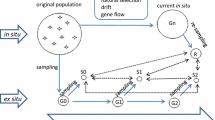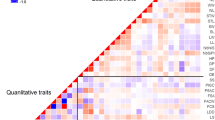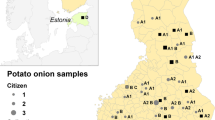Abstract
During a national Swedish collection mission of vegetable varieties conserved ‘on farm’ more than 70 pea accessions were obtained, many of which had been grown locally for more than 100 years. In spite of a likely origin in the multitude of obsolete commercial pea varieties available on the Swedish seed market in the nineteenth century, the rediscovered local cultivars have lost their original names and cultivar identity while being maintained ‘on farm’. To analyze genetic diversity in the repatriated material, 20 accessions were genotyped with twelve SSR markers and compared with 15 obsolete cultivars kept in genebanks and 13 cultivars preserved as non-viable seeds collected in 1877–1918. Most of the local cultivars were genetically distinct from each other, and in only a few cases could a possible origin in a tested obsolete cultivar be suggested. These results reflect the wide diversity of pea cultivars present in Sweden during the nineteenth century. Both between and within accession genetic diversity was larger among the historical samples of obsolete cultivars compared to local cultivars and cultivars preserved in genebanks, indicating genetic erosion over time both in genebanks and during conservation ‘on farm’. The constraints on identifying and verifying historical cultivars using genetic markers are discussed.



Similar content being viewed by others
References
Blixt S (1977) The gene symbols of Pisum. Pisum Genetics Newsletter 9: Supplement
Camacho-Villa TC, Maxted N, Scholten M, Ford-Lloyd B (2005) Defining and identifying crop landraces. Plant Gen Res 3:373–384
Cieslarová J, Smýkal P, Dočkalová Z, Hanáček P, Procházka S, Hýbl M et al (2010) Molecular evidence of genetic diversity changes in pea (Pisum sativum L.) germplasm after long-term maintenance. Genet Resour Crop Evol 58:439–451
Evanno G, Regnaut S, Goudet J (2005) Detecting the number of clusters of individuals using the software STRUCTURE: a simulation study. Mol Ecol 14:2611–2620
Falush D, Stephens M, Pritchard JK (2003) Inference of population structure using multilocus genotype data: linked loci and correlated allele frequencies. Genetics 164:1567–1587
Galluzzi G, Eyzaguirre P, Negri V (2010) Home gardens: neglected hotspots of agro-biodiversity and cultural diversity. Biodivers Conserv 19:3635–3654
Hagenblad J, Zie J, Leino MW (2012) Exploring the population genetics of genebank and historical landrace varieties. Genet Resour Crop Evol 59:1185–1199
Hjelmqvist H (1979) Beiträge zur Kenntnis der prähistorischen Nutzpflanzen in Schweden. Opera Bot 47:1–58
Jakobsson M, Rosenberg NA (2007) CLUMPP: a cluster matching and permutation program for dealing with label switching and multimodality in analysis of population structure. Bioinformatics 23:1801–1806
Johansson P, Aarsrud S, Öberg A-C (2003) Det underbara huset: Vänerborgs museum (The wonderful building: The Vänersborg Museum). Vänersborgs museums skriftserie, 1651-842X; 1
Kobayashi A, Ebana K, Fukuoka S, Nagamine T (2006) Microsatellite markers revealed the genetic diversity of an old Japanese rice landrace ‘Echizen’. Genet Resour Crop Evol 53:499–506
Leino MW, Hagenblad J, Edqvist J, Karlsson Strese E-M (2009) DNA preservation and utility of a historic seed collection. Seed Sci Res 19:125–135
Leino MW, Boström E, Hagenblad J (2013) Twentieth-century changes in the genetic composition of Swedish field pea metapopulations. Heredity 110:338–346
Loridon K, McPhee K, Morin J, Dubreuil P, Pilet-Nayel ML, Aubert G, Rameau C, Baranger A, Coyne C, Lejeune-Hènaut I, Burstin J (2005) Microsatellite marker polymorphism and mapping in pea (Pisum sativum L.). Theor Appl Genet 111:1022–1031
Nei M (1973) Analysis of gene diversity in subdivided populations. Proc Natl Acad Sci USA 70:3321–3323
Nygårds L, Leino MW (2013) Klint Karins kålrot och mor Kristins böna: om fröuppropets kulturarv (Klint Karin’s swede and mother Kristin’s bean: cultural heritage of the seed call). Swedish Univ Agric Sci, Alnarp
Osvald H (1959) Åkerns nyttoväxter (Agricultural utility plants). Stockholm
Poulsen G, Holten C, von Bothmer R (2007) AFLP similarities among Danish cultivars of fodder beet (Beta vulgaris L. subsp. vulgaris var. rapacea Koch). Genet Resour Crop Evol 54:1105–1115
Pritchard JK, Stephens M, Donnelly P (2000) Inference of population structure using multilocus genotype data. Genetics 155:945–959
Rosenberg NA (2004) Distruct: a program for the graphical display of population structure. Mol Ecol Notes 4:137–138
R Development Core Team (2007) R: A language and environment for statistical computing. R Foundation for Statistical Computing, Vienna, Austria. ISBN 3-900051-07-0, URL. http://www.R-project.org
Svensson K (2004) Trädgårdsärt och trädgårdsböna: kartläggning av de i Sverige marknadsförda sorterna 1850-1970 (Garden pea and garden bean: Inventory of varieties of the Swedish market between 1850-1970). Swedish Univ Agric Sci, Alnarp
van de Wouw M, van Treuren R, van Hintum T (2011) Authenticity of old cultivars in genebank collections: a case study on lettuce. Crop Sci 51:736–746
Veteläinen M, Negri V, Maxted N (2009) European landraces on-farm conservation, management and use. Bioversity Technical Bulletin No 15. Bioversity International, Rome
Wright S (1951) The genetical structure of populations. Ann Eugen 15:323–354
Zohary D, Hopf M, Weiss E (2012) Domestication of plants in the old world: the origin and spread of domesticated plants in south-west Asia, Europe, and the Mediterranean Basin, 4th edn. Oxford University Press, Oxford
Acknowledgments
We thank Svein Solberg and Fredrik Ottosson at the Nordic Genetic Resource Centre (NordGen), Alnarp, Sweden; Mike Ambrose at John Innes Centre, Norwich, UK and Ann-Charlotte Öberg at Vänersborgs museum, Vänersborg, Sweden for kindly providing the seed material. This work was funded by the Lagersberg foundation, the Swedish Board of Agriculture and the Royal Swedish Academy of Agriculture and Forestry (KSLA).
Author information
Authors and Affiliations
Corresponding author
Electronic supplementary material
Below is the link to the electronic supplementary material.
Rights and permissions
About this article
Cite this article
Hagenblad, J., Boström, E., Nygårds, L. et al. Genetic diversity in local cultivars of garden pea (Pisum sativum L.) conserved ‘on farm’ and in historical collections. Genet Resour Crop Evol 61, 413–422 (2014). https://doi.org/10.1007/s10722-013-0046-5
Received:
Accepted:
Published:
Issue Date:
DOI: https://doi.org/10.1007/s10722-013-0046-5




